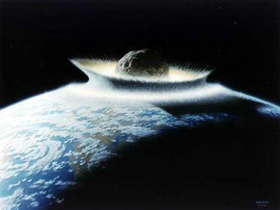Faced by the fact that amino acids cannot form by chance, evolutionists looked for a new explanation of how life might have arisen spontaneously under the conditions of the primeval world. According to their new claims, amino acids in meteors falling to Earth reacted with organic substances and thus gave rise to life.
According to this view, the first organic substance originated beyond the Earth, on another planet. The spores or seeds of these organisms were then carried to Earth by meteors, and life thus began. In the light of our current knowledge, however, it doesn't appear possible for spores or seeds to withstand such outer-space conditions as cold, utter vacuum, and harmful radiation on their way to Earth-not to mention the intense heat and impact of passing through the atmosphere.177
 It is impossible for meteors falling to Earth to carry living organisms with them because of the high temperatures created as they enter the atmosphere and the severity of their impacts. Above you can see a crater left by a meteorite in Arizona. Even if one postulates the existence of life beyond Earth, there can still be no other explanation for its origin than creation. |
Conditions in space make it impossible for life to survive. The well-known Russian scientist George Gamow says:
. . . there is a still more serious threat awaiting spores traveling through space than freezing to death. The Sun is well known to emit a significant level of ultraviolet rays. These rays, only a small proportion of which are permitted to pass through the atmospheric layer surrounding the Earth, represent the most serious danger to these micro-organism spores with no defensive mechanisms with which to protect themselves, and are sufficiently powerful to kill them instantaneously. For that reason, even a fictitious journey by these bacteria to the nearest planet will still result in death. Another study conducted in 1966 led to the "out of space" hypothesis being totally abandoned. The most highly resistant micro-organisms were installed on the outer surface of the spacecraft Gemini-9 and this was then launched into space. Examinations revealed that these micro-organisms all died within seven hours. Yet according to this hypothesis, the bacteria that supposedly gave rise to life must have traveled for many years. 178
The crystal-clear fact that emerges is that it is impossible for micro-organisms to reach Earth from outer space. However, even if large quantities of amino acids had come from space, and even if the entire surface of the primitive Earth world was covered with them, this would still not account for the origin of life. It would be impossible for amino acids to combine randomly and haphazardly and form an exceedingly complex, three-dimensional protein; for proteins to form the organelles in cells; and then for these organelles to produce the miraculous structure of the cell itself.
177. Özer Bulut, Davut Sağdıç, Selim Korkmaz, Biyoloji Lise 3, MEB Basımevi, Istanbul, 2000, p. 182.
178. Musa Özet, Osman Arpacı, Ali Uslu, Biyoloji 3, Sürat Yayınları, August 1999, p. 254.


